西妥昔单抗在头颈部鳞癌研究进展[2].ppt
- 格式:ppt
- 大小:2.13 MB
- 文档页数:55
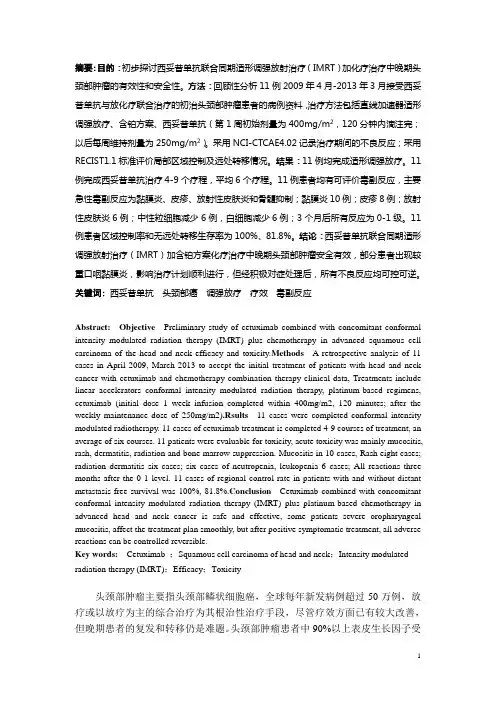
摘要:目的:初步探讨西妥昔单抗联合同期适形调强放射治疗(IMRT)加化疗治疗中晚期头颈部肿瘤的有效性和安全性。
方法:回顾性分析11例2009年4月-2013年3月接受西妥昔单抗与放化疗联合治疗的初治头颈部肿瘤患者的病例资料,治疗方法包括直线加速器适形调强放疗、含铂方案、西妥昔单抗(第1周初始剂量为400mg/m2,120分钟内滴注完;以后每周维持剂量为250mg/m2)。
采用NCI-CTCAE4.02记录治疗期间的不良反应;采用RECIST1.1标准评价局部区域控制及远处转移情况。
结果:11例均完成适形调强放疗。
11例完成西妥昔单抗治疗4-9个疗程,平均6个疗程。
11例患者均有可评价毒副反应,主要急性毒副反应为黏膜炎、皮疹、放射性皮肤炎和骨髓抑制;黏膜炎10例;皮疹8例;放射性皮肤炎6例;中性粒细胞减少6例,白细胞减少6例;3个月后所有反应为0-1级。
11例患者区域控制率和无远处转移生存率为100%、81.8%。
结论:西妥昔单抗联合同期适形调强放射治疗(IMRT)加含铂方案化疗治疗中晚期头颈部肿瘤安全有效,部分患者出现较重口咽黏膜炎,影响治疗计划顺利进行,但经积极对症处理后,所有不良反应均可控可逆。
关键词:西妥昔单抗头颈部癌调强放疗疗效毒副反应Abstract: Objective Preliminary study of cetuximab combined with concomitant conformal intensity modulated radiation therapy (IMRT) plus chemotherapy in advanced squamous cell carcinoma of the head and neck efficacy and toxicity.Methods A retrospective analysis of 11 cases in April 2009, March 2013 to accept the initial treatment of patients with head and neck cancer with cetuximab and chemotherapy combination therapy clinical data, Treatments include linear accelerators conformal intensity modulated radiation therapy, platinum-based regimens, cetuximab (initial dose 1 week infusion completed within 400mg/m2, 120 minutes; after the weekly maintenance dose of 250mg/m2).Rsults 11 cases were completed conformal intensity modulated radiotherapy. 11 cases of cetuximab treatment is completed 4-9 courses of treatment, an average of six courses. 11 patients were evaluable for toxicity, acute toxicity was mainly mucositis, rash, dermatitis, radiation and bone marrow suppression. Mucositis in 10 cases, Rash eight cases; radiation dermatitis six cases; six cases of neutropenia, leukopenia 6 cases; All reactions three months after the 0-1 level. 11 cases of regional control rate in patients with and without distant metastasis-free survival was 100%, 81.8%.Conclusion Cetuximab combined with concomitant conformal intensity modulated radiation therapy (IMRT) plus platinum-based chemotherapy in advanced head and neck cancer is safe and effective, some patients severe oropharyngeal mucositis, affect the treatment plan smoothly, but after positive symptomatic treatment, all adverse reactions can be controlled reversible.Key words: Cetuximab ;Squamous cell carcinoma of head and neck;Intensity modulated radiation therapy (IMRT);Efficacy;Toxicity头颈部肿瘤主要指头颈部鳞状细胞癌,全球每年新发病例超过50万例,放疗或以放疗为主的综合治疗为其根治性治疗手段,尽管疗效方面已有较大改善,但晚期患者的复发和转移仍是难题。
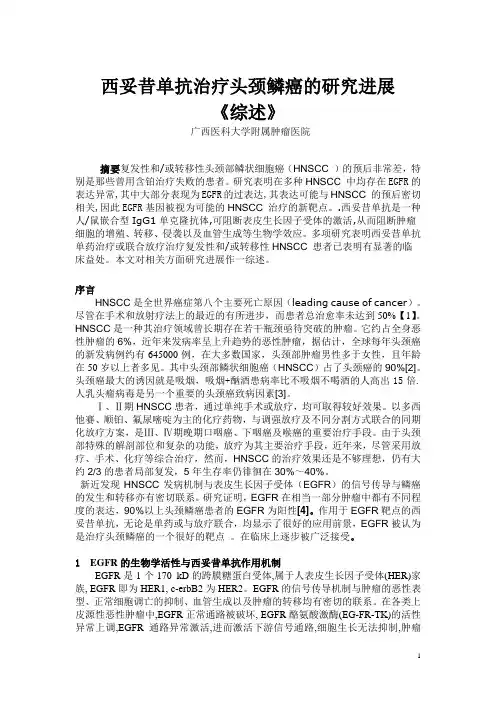
西妥昔单抗治疗头颈鳞癌的研究进展《综述》广西医科大学附属肿瘤医院摘要复发性和/或转移性头颈部鳞状细胞癌(HNSCC)的预后非常差,特别是那些曾用含铂治疗失败的患者。
研究表明在多种HNSCC中均存在EGFR的表达异常,其中大部分表现为EGFR的过表达,其表达可能与HNSCC的预后密切相关,因此EGFR基因被视为可能的HNSCC治疗的新靶点。
.西妥昔单抗是一种人/鼠嵌合型IgG1单克隆抗体,可阻断表皮生长因子受体的激活,从而阻断肿瘤细胞的增殖、转移、侵袭以及血管生成等生物学效应。
多项研究表明西妥昔单抗单药治疗或联合放疗治疗复发性和/或转移性HNSCC患者已表明有显著的临床益处。
本文对相关方面研究进展作一综述。
序言HNSCC是全世界癌症第八个主要死亡原因(leading cause of cancer)。
尽管在手术和放射疗法上的最近的有所进步,而患者总治愈率未达到50%【1】。
HNSCC是一种其治疗领域曾长期存在若干瓶颈亟待突破的肿瘤。
它约占全身恶性肿瘤的6%,近年来发病率呈上升趋势的恶性肿瘤,据估计,全球每年头颈癌的新发病例约有645000例,在大多数国家,头颈部肿瘤男性多于女性,且年龄在50岁以上者多见。
其中头颈部鳞状细胞癌(HNSCC)占了头颈癌的90%[2]。
头颈癌最大的诱因就是吸烟,吸烟+酗酒患病率比不吸烟不喝酒的人高出15倍.人乳头瘤病毒是另一个重要的头颈癌致病因素[3]。
Ⅰ、Ⅱ期HNSCC患者,通过单纯手术或放疗,均可取得较好效果。
以多西他赛、顺铂、氟尿嘧啶为主的化疗药物,与调强放疗及不同分割方式联合的同期化放疗方案,是Ⅲ、Ⅳ期晚期口咽癌、下咽癌及喉癌的重要治疗手段。
由于头颈部特殊的解剖部位和复杂的功能,放疗为其主要治疗手段,近年来,尽管采用放疗、手术、化疗等综合治疗,然而,HNSCC的治疗效果还是不够理想,仍有大约2/3的患者局部复发,5年生存率仍徘徊在30%~40%。
新近发现HNSCC发病机制与表皮生长因子受体(EGFR)的信号传导与鳞癌的发生和转移亦有密切联系。

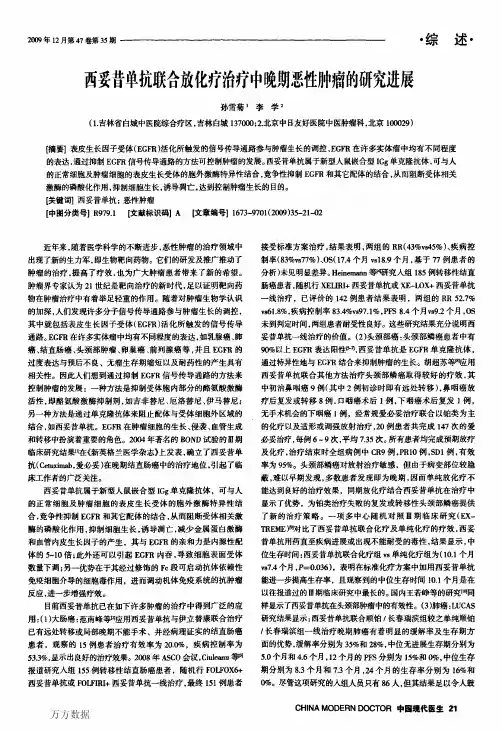
2009年12月第47卷第35期西妥昔单抗联合放化疗治疗中晚期恶性肿瘤的研究进展孙雪菊-李学:(1.吉林省白城中医院综合疗区,吉林白城137000;2.北京中日友好医院中医肿瘤科,北京100029)・综述・【}商要】表皮生长因子受体(EGFR)活化所触发的信号传导通路参与肿瘤生长的调控,EGFR在许多实体瘤中均有不同程度的表达,通过抑制EGFR信号传导通路的方法可控制肿瘤的发展。
西妥昔单抗属于新型人鼠嵌合型IGg单克隆抗体,可与人的正常细胞及肿瘤细胞的表皮生长受体的胞外激酶特异性结合,竞争性抑制EGFR和其它配体的结合,从而阻断受体相关激酶的磷酸化作用,抑制细胞生长,诱导凋亡,达到控制肿瘤生长的目的。
【关键词】西妥昔单抗;恶性肿瘤【中图分类号】R979.1【文献标识码】A【文章编号】1673-9701(2009)35—21-02近年来,随着医学科学的不断进步,恶性肿瘤的治疗领域中出现了新的生力军,即生物靶向药物。
它们的研发及推广推动了肿瘤的治疗,提高了疗效,也为广大肿瘤患者带来了新的希望。
肿瘤界专家认为21世纪是靶向治疗的新时代,足以证明靶向药物在肿瘤治疗中有着举足轻重的作用。
随着对肿瘤生物学认识的加深,人们发现许多分子信号传导通路参与肿瘤生长的调控,其中就包括表皮生长因子受体(EGFR)活化所触发的信号传导通路。
EGFR在许多实体瘤中均有不同程度的表达,如乳腺癌、肺癌、结直肠癌、头颈部肿瘤、卵巢癌、前列腺癌等,并且EGFR的过度表达与预后不良、无瘤生存期缩短以及耐药性的产生具有相关性。
因此人们想到通过抑制EGFR信号传导通路的方法来控制肿瘤的发展:一种方法是抑制受体胞内部分的酪氨酸激酶活性,即酪氨酸激酶抑制刺,如吉非替尼、厄洛替尼、伊马替尼;另一种方法是通过单克隆抗体来阻止配体与受体细胞外区域的结合,如西妥昔单抗。
EGFR在肿瘤细胞的生长、侵袭、血管生成和转移中扮演着重要的角色。
2004年著名的BOND试验的Ⅲ期临床研究结果【1在《新英格兰医学杂志》上发表,确立了西妥昔单抗(Cetl—ximab,爱必妥)在晚期结直肠癌中的治疗地位,引起了临床工作者的广泛关注。
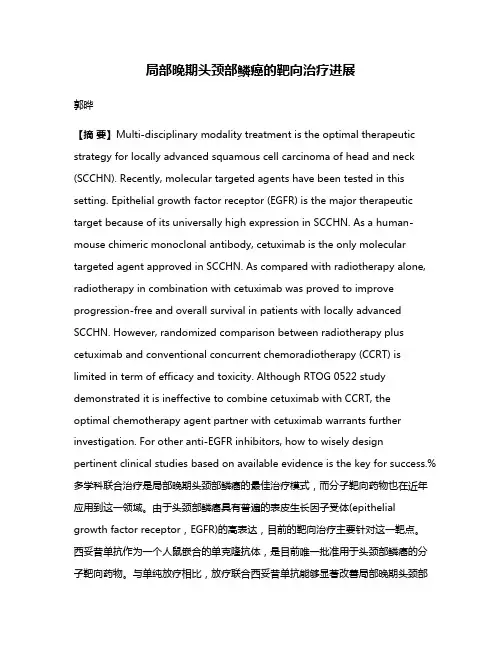
局部晚期头颈部鳞癌的靶向治疗进展郭晔【摘要】Multi-disciplinary modality treatment is the optimal therapeutic strategy for locally advanced squamous cell carcinoma of head and neck (SCCHN). Recently, molecular targeted agents have been tested in this setting. Epithelial growth factor receptor (EGFR) is the major therapeutic target because of its universally high expression in SCCHN. As a human-mouse chimeric monoclonal antibody, cetuximab is the only molecular targeted agent approved in SCCHN. As compared with radiotherapy alone, radiotherapy in combination with cetuximab was proved to improve progression-free and overall survival in patients with locally advanced SCCHN. However, randomized comparison between radiotherapy plus cetuximab and conventional concurrent chemoradiotherapy (CCRT) is limited in term of efficacy and toxicity. Although RTOG 0522 study demonstrated it is ineffective to combine cetuximab with CCRT, the optimal chemotherapy agent partner with cetuximab warrants further investigation. For other anti-EGFR inhibitors, how to wisely design pertinent clinical studies based on available evidence is the key for success.%多学科联合治疗是局部晚期头颈部鳞癌的最佳治疗模式,而分子靶向药物也在近年应用到这一领域。
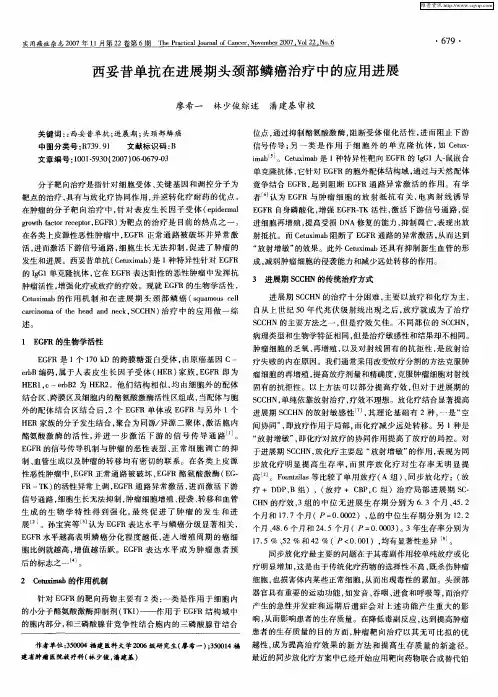
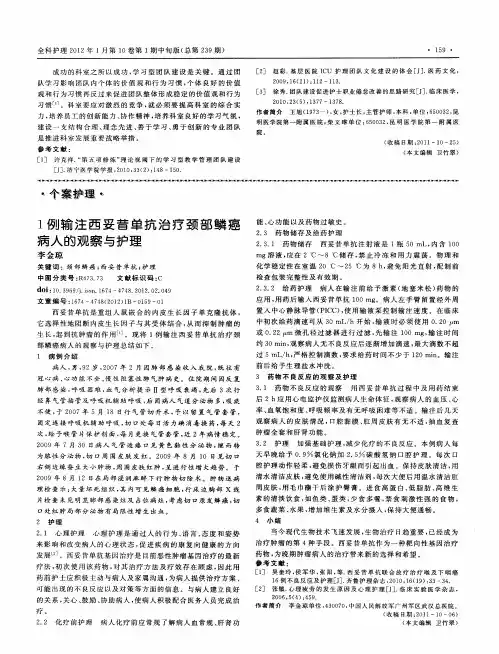

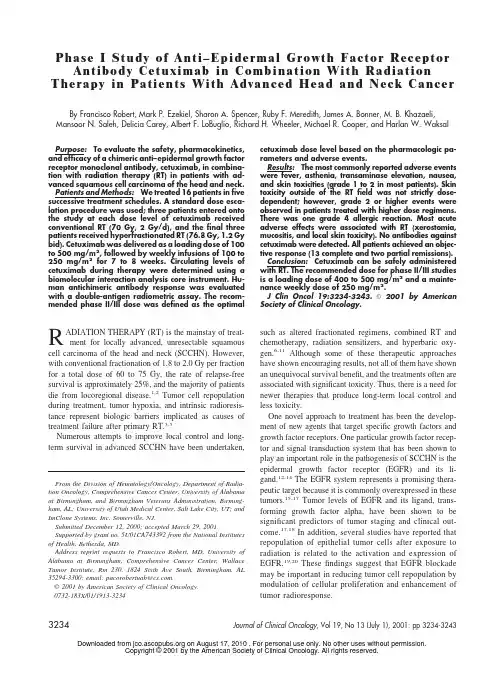
Phase I Study of Anti–Epidermal Growth Factor Receptor Antibody Cetuximab in Combination With Radiation Therapy in Patients With Advanced Head and Neck Cancer By Francisco Robert,Mark P.Ezekiel,Sharon A.Spencer,Ruby F.Meredith,James A.Bonner,M.B.Khazaeli, Mansoor N.Saleh,Delicia Carey,Albert F.LoBuglio,Richard H.Wheeler,Michael R.Cooper,and Harlan W.WaksalPurpose:To evaluate the safety,pharmacokinetics, and efficacy of a chimeric anti–epidermal growth factor receptor monoclonal antibody,cetuximab,in combina-tion with radiation therapy(RT)in patients with ad-vanced squamous cell carcinoma of the head and neck. Patients and Methods:We treated16patients infive successive treatment schedules.A standard dose esca-lation procedure was used;three patients entered onto the study at each dose level of cetuximab received conventional RT(70Gy,2Gy/d),and thefinal three patients received hyperfractionated RT(76.8Gy,1.2Gy bid).Cetuximab was delivered as a loading dose of100 to500mg/m2,followed by weekly infusions of100to 250mg/m2for7to8weeks.Circulating levels of cetuximab during therapy were determined using a biomolecular interaction analysis core instrument.Hu-man antichimeric antibody response was evaluated with a double-antigen radiometric assay.The recom-mended phase II/III dose was defined as the optimal cetuximab dose level based on the pharmacologic pa-rameters and adverse events.Results:The most commonly reported adverse events were fever,asthenia,transaminase elevation,nausea, and skin toxicities(grade1to2in most patients).Skin toxicity outside of the RTfield was not strictly dose-dependent;however,grade2or higher events were observed in patients treated with higher dose regimens. There was one grade4allergic reaction.Most acute adverse effects were associated with RT(xerostomia, mucositis,and local skin toxicity).No antibodies against cetuximab were detected.All patients achieved an objec-tive response(13complete and two partial remissions). Conclusion:Cetuximab can be safely administered with RT.The recommended dose for phase II/III studies is a loading dose of400to500mg/m2and a mainte-nance weekly dose of250mg/m2.J Clin Oncol19:3234-3243.©2001by American Society of Clinical Oncology.R ADIATION THERAPY(RT)is the mainstay of treat-ment for locally advanced,unresectable squamous cell carcinoma of the head and neck(SCCHN).However, with conventional fractionation of1.8to2.0Gy per fraction for a total dose of60to75Gy,the rate of relapse-free survival is approximately25%,and the majority of patients die from locoregional disease.1,2Tumor cell repopulation during treatment,tumor hypoxia,and intrinsic radioresis-tance represent biologic barriers implicated as causes of treatment failure after primary RT.3-5Numerous attempts to improve local control and long-term survival in advanced SCCHN have been undertaken,such as altered fractionated regimens,combined RT and chemotherapy,radiation sensitizers,and hyperbaric oxy-gen.6-11Although some of these therapeutic approaches have shown encouraging results,not all of them have shown an unequivocal survival benefit,and the treatments often are associated with significant toxicity.Thus,there is a need for newer therapies that produce long-term local control and less toxicity.One novel approach to treatment has been the develop-ment of new agents that target specific growth factors and growth factor receptors.One particular growth factor recep-tor and signal transduction system that has been shown to play an important role in the pathogenesis of SCCHN is the epidermal growth factor receptor(EGFR)and its li-gand.12-14The EGFR system represents a promising thera-peutic target because it is commonly overexpressed in these tumors.15-17Tumor levels of EGFR and its ligand,trans-forming growth factor alpha,have been shown to be significant predictors of tumor staging and clinical out-come.17,18In addition,several studies have reported that repopulation of epithelial tumor cells after exposure to radiation is related to the activation and expression of EGFR.19,20Thesefindings suggest that EGFR blockade may be important in reducing tumor cell repopulation by modulation of cellular proliferation and enhancement of tumor radioresponse.From the Division of Hematology/Oncology,Department of Radia-tion Oncology,Comprehensive Cancer Center,University of Alabamaat Birmingham,and Birmingham Veterans Administration,Birming-ham,AL;University of Utah Medical Center,Salt Lake City,UT;andImClone Systems,Inc,Somerville,NJ.Submitted December12,2000;accepted March29,2001.Supported by grant no.5U01CA743392from the National Institutesof Health,Bethesda,MD.Address reprint requests to Francisco Robert,MD,University ofAlabama at Birmingham,Comprehensive Cancer Center,WallaceTumor Institute,Rm230,1824Sixth Ave South,Birmingham,AL35294-3300;email:pacorobertuab@.©2001by American Society of Clinical Oncology.0732-183X/01/1913-32343234Journal of Clinical Oncology,Vol19,No13(July1),2001:pp3234-3243Inhibition of the EGFR-induced signal transduction path-ways,either by higher than physiologic concentrations of epidermal growth factor or by monoclonal antibodies (mAbs)directed at the EGFR,has been shown to inhibit the growth of EGFR-expressing human cancer cells.21-23One such antibody is cetuximab (C225;ImClone Systems,Inc,Somerville,NJ),a mouse-human chimeric anti-EGFR mAb that binds with high affinity to the receptor,blocks ligand-induced activation of receptor tyrosine kinase,and induces dimerization and downregulation of the EGFR,which prevents further receptor binding and activation by the ligands.24-28In addition,cetuximab has been shown to inhibit the proliferation of a variety of cultured human tumor cell lines that overexpress EGFR and to enhance the antitumor activity of several chemotherapeutic agents in xenograft models.27,28-30Furthermore,we and others have shown that cetuximab enhanced the radioresponse of EGFR-expressing A431tumor cells in vitro and in tumor xenografts.31,32Given the correlation of EGFR expression with poor prognosis and the fact that preclinical studies identified cetuximab as a radiosensitizer,a phase I study was under-taken to assess the interaction of cetuximab and RT in patients with locally advanced,unresectable SCCHN.The purposes of this study were to establish a safety profile of cetuximab administered over a range of dose levels during RT and to determine the dose-dependent pharmacokinetics and human immune response to the antibody.PATIENTS AND METHODSThis single-center,phase I,open-label study evaluated different dose levels of cetuximab with concomitant RT in patients with locally advanced SCCHN.Five treatment groups (Table 1)with at least three assessable patients were considered for this study to determine the recommended phase II/III dose.Patients received eight to nine weekly infusions of cetuximab.The initial infusion was a loading dose of either 100,200,400,or 500mg/m 2administered over 60to 120minutes.Subsequent infusions of cetuximab consisted of 100-,200-,or 250-mg/m 2maintenance doses administered over 60minutes.Single daily fractions or twice-daily hyperfractionated RT was started on day 8(week 2)of the treatment course and continued for approximately 7weeks.The protocol was approved by the institutional review board,and all patients gave written informed consent before they were entered onto the study.Patient EligibilityPatients enrolled onto this study were at least 18years old and had a histologically confirmed diagnosis of SCCHN.The inclusion criteria were as follows:all sites of the head and neck except the nasopharynx,stage III or IV 33disease or recurrent disease that was not resectable for curative intent,no evidence of metastatic disease,and no history of prior RT or chemotherapy.In addition,patients had a Karnofsky performance status of at least 60%and preserved hematologic param-eters (absolute neutrophil count Ն1,500/L,platelet count Ն100,000/L,and hemoglobin level Ն9gm/dL),liver function (alkaline phosphatase Ͻ2.6times the normal limit,AST level Ͻ2.6times the normal limit,and total bilirubin Ͻ1.5times the normal limit),and normal renal function (creatinine Ͻ 1.5times the normal limit).Exclusion criteria were pregnancy or lactation,prior murine mAb or cetuximab therapy,significant comorbid conditions,or investigational therapy for diseases within 1month of study entry.Representative tumor tissue (paraffin tumor blocks)for EGFR assessment was obtained before the start of the study,but a positive result was not required as a prestudy parameter because of the high reported expression levels in SCCHN.17,18The presence of the EGFR was determined in a two-step immunostaining process,which involved,first,the binding of a murine anti-EGFR antibody (M225)to the receptor and,second,the detection and visualization of bound antibody by application of an enzyme chromogenic reagent.Tumors were considered to overexpress EGFR if positive cytoplasmic rimming was observed in 10%or more of the cells.All patients were evaluated initially by a multidisciplinary team that consisted of radiation oncologists,otolaryngologists,and medical oncologists.The stage of the tumor was determined on the basis of a physical examination,chest x-ray,and computed tomography or magnetic resonance imaging of the head and neck.A routine blood chemical analysis,complete blood count,and urinalysis were per-formed within 2weeks before enrollment.Dental evaluation was performed in each patient,and at least 10days were allowed for healing gingivae after extraction.DefinitionsDose-limiting toxicity (DLT)was defined as grade 3or higher toxicity as determined by the Cancer and Leukemia Group B expanded common toxicity criteria and the Radiation Therapy Oncology GroupTable 1.Study DesignTreatment Group No.of PatientsRTCetuximab Loading Dose (mg/m 2)Cetuximab Loading Infusion Time (min)Cetuximab Maintenance Dose(mg/m 2)Cetuximab Maintenance Infusion Time (min)13qd 10060100q 1wk ϫ76024*qd 20060200q 1wk ϫ76033qd 400120200q 1wk ϫ76043qd 500120250q 1wk ϫ76053bid 400120250q 1wk ϫ760Abbreviations:qd,single daily fraction,bid,twice-daily fractions;q 1wk,once a week.*One patient was replaced because of a grade 4allergic reaction during the initial infusion of cetuximab.3235CETUXIMAB PLUS RT IN HEAD-NECK CANCER(RTOG)acute radiation morbidity scoring criteria.Excluded from thedefinition of DLT were allergic reactions,asthenia,grade3mucositis, and grade3skin toxicity(within and outside of the RTfields).The definition of grade3skin toxicity outside of the RTfield was expanded to include confluence,pain,and erosion of the skin.Grade4skin toxicity was defined as exfoliative or ulcerating generalized dermatitis. Any patients who experienced a grade4allergic reaction were removed from the study and replaced in the same treatment group.The maximum-tolerated dose was defined as the highest dose level at which zero of three or one offive patients experienced a DLT.The recommended phase II/III dose was defined as the optimal cetuximab dose level based on pharmacologic parameters and adverse events. Investigational AgentCetuximab(C225)was provided by ImClone Systems as an inject-able solution in either10-mL or50-mL vials that contained2mg/mL of the antibody.Before infusion,cetuximab wasfiltered with a 0.22-m protein-sparingfilter.Treatment PlanPatients were enrolled sequentially ontofive treatment groups that comprised at least three assessable patients in each group,with all patients at the preceding dose level having received at least two doses of cetuximab(Table1).Dose escalation proceeded in the absence of a study drug–related DLT.If,at any dose level,one of the three patients experienced a DLT,two additional patients were to be enrolled at that dose level.Patients received eight to nine weekly cetuximab infusions with an initial loading dose on day1that ranged from100to500mg/m2 administered intravenously over60or120minutes(Table1).Subse-quent infusions of cetuximab consisted of100-,200-,and250-mg/m2 maintenance doses administered over60minutes.Patients received a test dose of cetuximab(20mg)over10minutes before the initial loading dose.They received the remainder of their infusion after completion of the observation period(30minutes).Patients were premedicated with diphenhydramine(50mg intravenously)and an H2 blocker before the test dose.All treatments were given in the outpatient setting.Vital-sign measurements were obtained before administration of cetuximab,midway through the infusion,and every15minutes during the1-hour observation period after administration of the antibody therapy.The weekly doses of cetuximab were scheduled for Mondays and were administered before RT.An additional weekly infusion of cetuximab(ninth dose)was given to patients who required RT breaks.If a patient experienced a grade1or2allergic reaction,premedita-tion with50mg of diphenhydramine and an H2receptor antagonist was administered before each treatment with cetuximab.The duration of the remaining and subsequent infusions was increased,but it did not exceed4hours.Concurrent treatment with oral diphenhydramine and a topical antibiotic was considered for skin toxicity grades1through3. In addition,cetuximab dose reduction and/or dose delays were required for grade3skin toxicity.In the event of a grade4skin toxicity or grade 4allergic reaction,the patient was removed from the study.RT began on day8(week2).Patients in four initial treatment groups received once-daily RT that consisted of2.0Gy per fraction,five fractions per week,for a total dose of70Gy in7weeks.After administration of50Gy,boostfields to the primary tumor and gross nodal disease with margin were given with photons or electrons in the 4-to20-MeV range.The entire neck and supraclavicular regions were irradiated to a dose of at least44Gy.Patients in the last treatment group received RT bid that consisted of1.2Gy per fraction,10fractions per week,for a total of76.8Gy in7weeks.After administration of45.6 Gy,boostfields to the primary tumor and gross nodal disease with margin were given with photons or electrons in the4-to20-MeV range. The entire neck and supraclavicular regions were irradiated to a dose of at least45.6Gy.Treatment breaks because of confluent mucositis (gradeՆ3)were allowed,but they were restricted to5days. Surgical treatment was used only after the completion of therapy. Neck dissection was permitted for any patient with residual cervical adenopathy or as a planned treatment for any nodal disease with an initial diameter of3cm or more.Pharmacokinetics and Whole-Body Retention DataSerum samples for analysis of circulating cetuximab were obtained during each treatment at the following time intervals:before the infusion of cetuximab and at1,24,48,72,and96hours after infusion with doses1,4,and8.Samples were collected before infusion and1 hour after infusion with doses2,3,5,6,and7.Serum concentrations of cetuximab were determined using a Bio-sensor(Pharmacia,Uppsala,Sweden)biomolecular interaction analysis core instrument,which measures changes in surface plasmon reso-nance.In this method,a serum sample that contains the antibody is flowed over a dextran-coated foldfilm to which EGFR has been conjugated.The binding of cetuximab to the immobilized EGFR produces a change in the angle of light reflected from the goldfilm,and from this relationship,a standard curve can be created to express the concentration of cetuximab in the serum sample.In addition,whole-body probe counts were performed after radiola-beled antibody infusion in patients in treatment groups1through4 only.For each dose,approximately1mg of cetuximab was radiola-beled with10mCi of iodine-131(131I)and was administered intrave-nously over2to3minutes after the infusion of thefirst(loading dose) and last maintenance dose of unlabeled cetuximab.Radiolabeling was performed under aseptic conditions using standard iodogen methodol-ogy.Quality control of the radiolabeled product was monitored by immunoreactivity,high-performance liquid chromatography analy-sis,limulus amebocyte lysate assay,and sterility testing.To block uptake of131I by the thyroid,patients received a saturated solution of potassium iodide,beginning48hours before the administration of 131I-cetuximab and continuing for14days.Serial total-body sodium iodide probe counts were measured to determine whole-body retention data from each patient during thefirst andfinal131I-cetuximab infusions.The residence time(area under the curve of a percentage of the injected dose)was calculated using a trapezoidal integration method.The biologic half-life(T1/2)for131I-cetuximab also was derived from a monoexponential regressionfit of whole-body count data.Human Antichimeric Antibody ResponsePatients were monitored to determine whether the administration of cetuximab resulted in the production of human antichimeric antibodies (HACAs).Sera obtained before thefirst infusion and throughout the subsequent treatment period were analyzed with a double-antigen radiometric assay specific for cetuximab.34,35The results are expressed as nanograms per milliliter of bound antibody.A positive response is greater than10ng/mL antibody bound and greater than two times the preinfusion levels.3236ROBERT ET ALCriteria for Toxicity and ResponseSystemic and local adverse events were graded in accordance with the Cancer and Leukemia Group B expanded common toxicity criteria and the RTOG morbidity scoring criteria.Safety was assessed by physical examination and laboratory evaluations(complete blood count,chemical profile,and urinalysis)for the duration of the treatment and follow-up.The initial tumor response assessment was performed4to6weeks after treatment was completed.Tumor response was determined by physical examination and imaging studies(computed tomography or magnetic resonance imaging).Extended follow-up was performed at approximately3-month intervals.A complete response was defined as resolution of all evidence of measurable and assessable disease.A partial response was defined as a50%or greater reduction in the sum of the products of the longest perpendicular diameters of measurable lesions,with no new lesion development.Progressive disease was defined as a greater than25%increase of the sum of the products of the maximum diameters of the measurable lesions or the appearance of a new lesion.In addition to analyzing tumor response,we analyzed several clinical events,including the time to progression,actuarial locoregional progression-free survival,and overall survival.These data were analyzed using the Kaplan-Meier method.36The Student’s t test was used for the comparison of the resident time and biologic T1/2 between thefirst and last radiolabeled antibody infusions.RESULTSPatient CharacteristicsA total of16patients were enrolled onto this study between April1997and August1998.Table2outlines thecharacteristics of the patients.The median age was55years (range,34to72years).Fifteen patients were treatment-naı¨ve,and one patient with recurrent disease had been treated previously with surgery.The majority of patients (81%)had stage IV disease.Nodal metastases were present in81%of the patients,and six patients had N2disease.Of a total of15patients tested for tumor EGFR expression, only two were negative.Of the16patients,15received the planned cetuximab infusions and RT,with minimal interruption or delay. One patient in the second treatment group developed a reversible grade4anaphylactic reaction approximately5 minutes into thefirst infusion,which required his re-moval from the study.ToxicityA total of125cetuximab infusions were administered, with a mean of eight infusions per patient.Treatment with cetuximab and RT was well tolerated.The adverse events encountered in the present study for all patients and by treatment group are listed in Tables3and4,respectively. The most common adverse experiences thought to be related to the antibody therapy were asthenia,fever,nausea, and skin toxicities.Skin toxicities included acneiform-follicular rashes(mainly on the scalp,face,and truck)and maculopapular eruptions.The onset of these cutaneous manifestations usually occurred during thefirst3weeks of therapy,with complete resolution or stabilization with continued therapy.Only one patient(treatment group4) developed grade3skin toxicity related to cetuximab(out of the RTfield),which was characterized by symptomatic (pruritic)generalized maculopapular eruption after thefirst antibody infusion.The incidence of skin toxicity outside of the RTfields was not strictly dose-dependent;however, grade2and higher skin eruptions were observed only in patients treated with higher-dose regimens(treatment groups4and5).Four patients experienced allergic reactions during the first infusion(Table3).Two of these patients had a grade3 or higher reaction;one patient with reversible anaphylactic reaction(grade4)was removed from the study.Patients with allergic reactions lower than grade4received subse-quent infusions with premedication(diphenhydramine and H2-receptor antagonists),and the time of infusions was increased.No further allergic manifestations were observed in these patients after these treatment alterations.Most of the acute grade2and higher adverse events observed during treatment were associated with standardTable2.Patient CharacteristicsCharacteristicNo.of Patients(Nϭ16) Age,yearsMedian55 Range34-72 SexMale12 Female4 Performance status90%3 80%7 70%6 Primary siteOral cavity3 Oropharynx9 Larynx2 Hypopharynx2 AJCC stageIII3IV13 Tumor stageT23T36T47 Nodal stageN04N16N26 Abbreviation:AJCC,American Joint Committee on Cancer.3237CETUXIMAB PLUS RT IN HEAD-NECK CANCERaggressive irradiation,ie,xerostomia,mucositis,odynopha-gia,and local skin toxicity in the radiotherapyfields(Table 4).The incidence of confluent mucositis and local skin toxicity was virtually the same in all of the treatment groups.Long-term effects of treatment included mild to moderate xerostomia in the great majority of the patients and one case of soft tissue necrosis with exposure of bone. Pharmacokinetics and Whole-Body Retention DataThe cetuximab concentration-versus-time data during treatment for thefive treatment groups are shown in Fig1. Visual inspection of the individual concentration versus time curves indicates that circulating cetuximab peak and trough levels increased progressively in patients treated with loading doses of100to500mg/m2and maintenance weekly doses of100to250mg/m2.The mean serum peak levels in thefirst four treatment groups were358,656, 1,291,and1,478nmol/L.Mean serum trough levels in the same treatment groups were39,202,504,and772nmol/L.It is obvious that the interpatient variability with thesefixed regimens is high,especially at higher doses of cetuximab. The mean Km(the concentration of the antibody at which its elimination is half of its maximum)for this group of patients was482nmol/L.The inadequacy of thefirst two dosing regimens is readily apparent.The concentrations of cetuximab generated with these two dosing regimens per-sistently fell below the population Km,which indicates that within this dose range,saturation of drug clearance was not achieved.A complete analysis of the pharmacokinetic data will be presented in a separate report.The sodium iodide probe count data from thefirst and last infusion of cetuximab for thefirst four treatments groups is shown in Fig2.The mean value for the residence time in the first infusion was85.3hours,as compared with83.7hours for the last infusion(Pϭ.69;t test).The mean biologic T1/2 was94.5hours with thefirst infusion and89.6hours with the last infusion.Individual patient data indicate a trend in the residence time and biologic T1/2with increased doses of cetuximab.HACA ResponseThe sera of14patients who completed therapy were analyzed for the presence of HACAs.None of these patients developed an immune response to cetuximab.Clinical ResponsesFifteen patients were assessable for response and locore-gional control.Thirteen patients achieved a complete re-Table3.Adverse Events During Therapy*EventGradeTotal No. 1234Allergic reaction†11114 Asthenia703010 Chills10001 Fever380011 Injection site reaction20002 Anorexia12003 Diarrhea21003 Xerostomia†2130015 Odynophagia†0411015 Nausea1440018 Vomiting41005 Mucositis†0411015 Skin toxicity outside RTfields‡1031014 Skin toxicity within RTfields§195015 Arthralgia13004 Myalgia21003 Paresthesia10001 Alopecia10001 Conjunctivitis10001 Anemia1200012 Leukopenia90009 Thrombocytopenia40004 Creatinine elevation10001 Alkaline phosphataseelevation60006 AST elevation80008*Number of adverse events during the administration of125cetuximab infusions plus RT.†Worst toxicity during therapy.‡Worst cetuximab-related skin toxicity during therapy.§Worst RT-induced skin toxicity.Table4.Adverse Events by Treatment GroupToxicity GradeNo.of Patients by Treatment Group12345 Mucositis100000211011322322400000 Odynophagia100000211110322223400000 Xerostomia100011233322300000400000 Skin,infield100001232121301211400000 Skin,outside of the RTfield1233112000123000104000003238ROBERT ET ALsponse,and two patients achieved a partial response (Table 5).One of the partial responders,a patient with a T3N2cMo tumor,underwent bilateral neck dissection after completion of RT for persistent disease and has remained free of disease for more than 22months.The median duration of response for all patients was 28months.The median follow-up of surviving patients was 36months (range,23to 42months).Six patients had relapsed,with a median time to progression of 8months (range,4.5to 31months).All recurrences were at the locoregionalsites.Five of these patients died from progressive disease,and the cause of death of one patient is unknown.The actuarial 1-and 2-year disease-free survival rates were 73%and 65%,respectively.The median survival of these pa-tients has not been reached.DISCUSSIONThe combination of cetuximab and RT was well tolerated in this group of patients with advanced SCCHN.The most common reported cetuximab-related adverse eventswereFig 1.Serum levels of cetux-imab during therapy shown on a semilogarithmic plot scale at dose levels of (A)100/100mg/m 2,(B)200/200mg/m 2,(C)400/200mg/m 2,(D)500/250mg/m 2,and (E)400/250mg/m 2loading and maintenance regimens.3239CETUXIMAB PLUS RT IN HEAD-NECK CANCERfever,asthenia,transaminase elevation,nausea,and skin toxicities.These adverse events were grades 1and 2in the majority of the patients and were not related to the dose level of the antibody therapy.Only one patient experienced grade 3skin toxicity (a follicular/maculopapular rash)outside of the RT fields.Otherwise,the majority of the grade 2and 3skin toxicities were within the RT fields and not necessarily related to cetuximab therapy.In addition to the skin toxicity,one patient experienced a grade 4anaphy-lactic reaction shortly after the initiation of the first cetux-imab infusion,which was completely reversible.The re-mainder of the grade 2and 3antibody-related local/systemic toxicities were of little consequence and required no cetuximab dose modification or RT delays.In recent studies of hyperfractionated RT alone or com-bined RT and chemotherapy,the most common grade 3adverse event was acute mucositis in 67%to 77%of patients.11,37,38In the first report of RTOG 9003,the incidence of grade 3or worse acute mucositis was 25%for standard fractionation and 43%for altered fractionation RT.9In that study,the incidence of grade 3or higher skin toxicity was 7%for standard fractionation and 9%for altered fractionation RT.In our study,the incidence of grade 3mucositis was 73%,and the incidence of grade 3in-field skin toxicity was 33%.An important relevant issue is whether cetuximab increases the local toxicity of RT.Our data suggest some enhanced toxicity,which implies a biologic interaction between the antibody and RT.How-ever,a definite conclusion cannot be reached at this time because of the small number of patients in this study.A critical issue in clinical studies with an anti-EGFR mAb is definition of the optimal biologic dose and schedule.The hypothesis that has driven the clinical development of cetuximab is that complete saturation of EGFR binding might require saturation of the mechanism(s)responsible for the antibody’s elimination from the body.Indeed,it is likely that a major route for cetuximab clearance involves the binding of the antibody to EGFR on hepatocytes,with subsequent internalization of the cetuximab-EGFR com-plex.On the basis of this hypothesis,the optimal biologic dose is the lowest dose of cetuximab required to continu-ously maintain zero-order antibody elimination.Analysis of the pharmacokinetic data of previous phase I studies has shown that cetuximab displayed nonlinear phar-macokinetics,with antibody doses in the range of 200to 400mg/m 2associated with complete saturation of systemic clearance.39On the basis of these findings,therecom-Fig 2.Whole-body retention data after 131I-cetuximab admin-istration during the first and last infusions at different dose levels (100/100mg/m 2,patient nos.1to 3;200/200mg/m 2,patient nos.4,6,and 7;400/200mg/m 2,patient nos.8to 10;and 500/250mg/m 2,patient nos.11to 13).(A)Residence time;(B)biologic T 1/2.Table 5.Clinical Response and DurationPatient No.Treatment GroupPrimary Site TNM/StageClinical ResponseDuration of Response (months)11Base of tongue T3N1M0/III CR 621Tonsil T3N0M0/III CR 39ϩ31TonsilT2N2BM0/IV CR 37ϩ42Base of tongue T3N2BM0/IV CR 33ϩ52Tonsil T3N0M0/III CR 2862LarynxT4N1M0/IV CR 373Retromolar trigone T4N2BM0/IV CR 28ϩ83Oral tongue T4N1M0/IV CR 393Hypopharynx T4N0M0/IV CR 5ϩ104TonsilT2N2BM0/IV CR 30ϩ114Floor of mouth T4N0M0/IV PR 3124TonsilT4N1M0/IV CR 25ϩ135Soft palate T2N2CM0/IV CR 11145Tonsil T3N1M0/IV CR 24ϩ155Larynx T3N2CM0/IV PR 21ϩAbbreviations:TNM,AJCC primary tumor,nodal status,and distant metastases staging system;CR,complete response;PR,partial response.3240ROBERT ET AL。

28 世界睡眠医学杂志WorldJournalofSleepMedicine2021年1月第8卷第1期January.2021,Vol.8,No.1西妥昔单抗联合同步放化疗治疗局部头颈部鳞癌的疗效及对患者睡眠质量的影响王婉丽(广东省珠海市斗门区侨立中医院耳鼻喉科/珠海市第二中医院,珠海,519000)摘要 目的:研究西妥昔单抗联合同步放化疗治疗局部头颈部鳞癌的疗效及对患者睡眠质量的影响。
方法:选取珠海市第二中医院收治的局部头颈部鳞癌患者100例作为研究对象,按治疗方案分为观察组和对照组,每组50例。
观察组行西妥昔单抗联合同步放化疗,对照组行单一同步放化疗,分析比较2组患者临床疗效。
结果:观察组治疗总有效率比对照组高,治疗后PSQI评分以及不良反应发生率均比对照组低(P<0 05)。
结论:西妥昔单抗联合同步放化疗有助于提高局部头颈部鳞癌近期疗效,值得临床应用。
关键词 局部头颈部鳞癌;西妥昔单抗;同步放化疗;睡眠质量EffectofCetuximabCombinedwithConcurrentChemoradiotherapyonLocalHeadandNeckSquamousCellCarcinomaandItsInfluenceonSleepQualityofPatientsWANGWanli(OtolaryngologyDepartment,QiaoliHospitalofTraditionalChineseMedicine,DoumenDistrict,Zhuhaicity,GuangdongProvince/No 2MiddleSchoolHospitalofZhuhaiCity,Zhuhai519000,China)Abstract Objective:Tostudytheeffectofcetuximabcombinedwithconcurrentradiotherapyandchemotherapyinthetreatmentoflocalheadandnecksquamouscellcarcinomaanditseffectonpatients′sleepquality Methods:Atotalof100casesoflocalheadandnecksquamouscellcarcinomapatientsadmittedtoourhospitalweredividedintogroupsaccordingtotreatmentplan Theobservationgroupreceivedcetuximabcombinedwithconcurrentchemotherapyandradiotherapy,andthecontrolgroupreceivedsin gleconcurrentchemotherapy Theclinicalefficacyofthetwogroupswasanalyzedandcompared Results:Thetotaleffectiverateoftreatmentintheobservationgroupwashigherthanthatinthecontrolgroup,andthePSQIscoreandtheincidenceofadversereac tionsaftertreatmentwerelowerthanthoseinthecontrolgroup(P<0 05) Conclusion:Cetuximabcombinedwithconcurrentra diotherapyandchemotherapycanimprovetheshort termcurativeeffectoflocalheadandnecksquamouscellcarcinoma,andisworthyofclinicalapplication.Keywords Localheadandnecksquamouscellcarcinoma;Cetuximab;Concurrentchemoradiotherapy;Thequalityofsleep中图分类号:R338 63文献标识码:Adoi:10.3969/j.issn.2095-7130.2021.01.010 头颈部肿瘤中约有90%为鳞状细胞癌,局部头颈部鳞癌生物学特征较为独特,并且大部分患者均存在周围器官侵犯表现,使得局部组织层次模糊、解剖标志不明显等,导致后续手术治疗难度增加[1]。
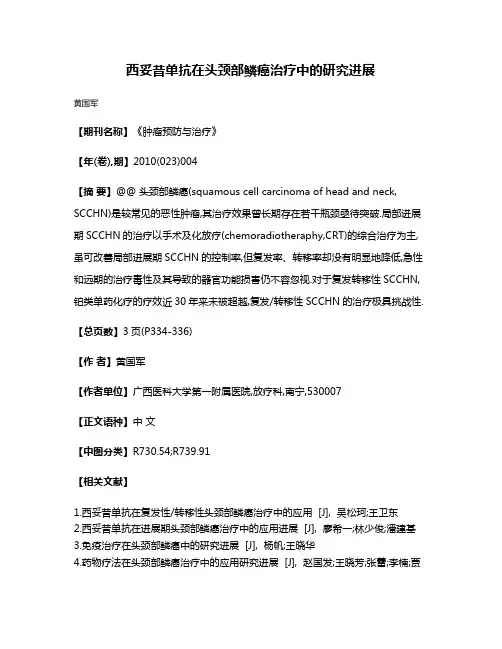
西妥昔单抗在头颈部鳞癌治疗中的研究进展
黄国军
【期刊名称】《肿瘤预防与治疗》
【年(卷),期】2010(023)004
【摘要】@@ 头颈部鳞癌(squamous cell carcinoma of head and neck, SCCHN)是较常见的恶性肿瘤,其治疗效果曾长期存在若干瓶颈亟待突破.局部进展期SCCHN的治疗以手术及化放疗(chemoradiotheraphy,CRT)的综合治疗为主,虽可改善局部进展期SCCHN的控制率,但复发率、转移率却没有明显地降低,急性和远期的治疗毒性及其导致的器官功能损害仍不容忽视.对于复发转移性SCCHN,铂类单药化疗的疗效近30年来未被超越,复发/转移性SCCHN的治疗极具挑战性.【总页数】3页(P334-336)
【作者】黄国军
【作者单位】广西医科大学第一附属医院,放疗科,南宁,530007
【正文语种】中文
【中图分类】R730.54;R739.91
【相关文献】
1.西妥昔单抗在复发性/转移性头颈部鳞癌治疗中的应用 [J], 吴松珂;王卫东
2.西妥昔单抗在进展期头颈部鳞癌治疗中的应用进展 [J], 廖希一;林少俊;潘建基
3.免疫治疗在头颈部鳞癌中的研究进展 [J], 杨帆;王晓华
4.药物疗法在头颈部鳞癌治疗中的应用研究进展 [J], 赵国发;王晓芳;张蕾;李楠;贾
友超
5.自然杀伤细胞在头颈部鳞癌发展及治疗中的研究进展 [J], 王鹿鸣;谢尚
因版权原因,仅展示原文概要,查看原文内容请购买。
西妥昔单抗能提高头颈癌患者的存活率
陶林
【期刊名称】《国外医学:药学分册》
【年(卷),期】2004(31)6
【总页数】1页(P376-376)
【关键词】西妥昔单抗;头颈癌;存活率;表皮生长因子受体;治疗
【作者】陶林
【作者单位】
【正文语种】中文
【中图分类】R739.91
【相关文献】
1.西妥昔单抗治疗高龄患者头颈部鳞状细胞癌1例报告 [J], 方烨;李曙平;姜辉;李太勇
2.提高谷胱甘肽-S转移酶含量能治疗帕金森病/表皮生长因子受体阻滞剂埃罗替尼可明显延长胰腺癌患者寿命/Erbitux能延长转移性头颈癌患者的生存期/澳大利亚召回肠易激综合征治疗药Zelnorm/精神抑制药可导致阿尔茨海默病患者早亡 [J],
3.Salmetererol能帮助提高治疗COPD的疗效/放疗与西妥昔单抗联合治疗头颈部鳞状上皮细胞癌 [J],
4.西妥昔单抗(艾比特思)给晚期头颈癌患者带来希望 [J],
5.术后化疗可提高壶腹周围癌患者存活率 [J],
因版权原因,仅展示原文概要,查看原文内容请购买。